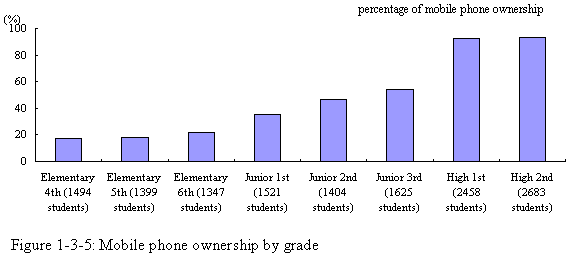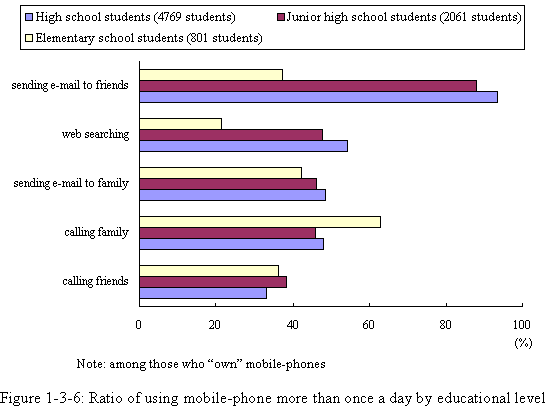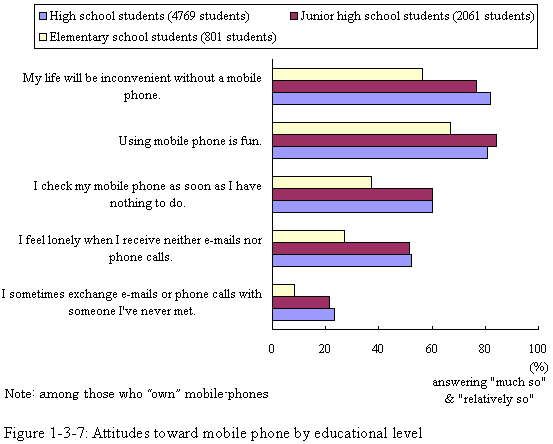Basic Survey on Daily Life of Children in Japan I
Mobile Phone Ownership Rate
Figure 1-3-5 shows mobile phone ownership rate by educational level and grade. The percentage rises consistently with each grade. In elementary school, the ownership rate is low, around 20%, however in junior high school, the percentage rises in the higher grades and reaches over 50% in the third grade. As for high school students, more than 90% of them have a mobile phone and using mobile phones is becoming the norm in daily life. Table 1-3-3 shows the difference by sex. In every educational level, girls' ownership rate is higher than that of boys. In junior high school, in particular, there is a significant difference between boys and girls in the number who own mobile phones. Table 1-3-4 shows the percentage of mobile phone owners among students according to the size of region: big city, medium-sized city, and rural district. Regardless of region, more than 90% of high school students own mobile phones. Among elementary and junior high school students, the percentage of those who live in big cities makes up the highest percentage, 29.4%, 63.0%, respectively. This could be explained by the fact that in big cities parents are more worried about their children in terms of security and give them a mobile phone so that they can be reached at any time after school. Students in big cities are likely to think that mobile phones are very useful for friendships.
Table 1-3-4: Ratio of mobile phone ownership by educational level and region
How Do Children Use Mobile Phones?
Students who own mobile phones were asked about their mobile phone usage. Figure 1-3-6 shows the percentage of students who said "yes" to each item about what they do with mobile phones at least once a day. Though elementary school children do not use mobile phones frequently, the highest percentage replied "calling family members, followed by "sending a text message to family members." They seem to call or send a text message to a family member when they go to and from cram school. Among junior high school and high school children, around 90% students replied "sending text message to friends," followed by "doing Internet search." They use text messaging as a communication tool more frequently than the phone. Nowadays, exchanging e-mail seems to be indispensable for friendship. Table 1-3-5 shows the difference by educational level and sex. More girls send text messages to friends in every educational level. Girls also send text messages to family members more frequently than boys. Girls seem to like sending text messaging.
Attitude Toward Mobile Phone; How Students Feel About Mobile Phones
The survey asked students who own a mobile phone about how they feel or think about mobile phone. Figure 1-3-7 shows the percentage of students who answered "yes" to each of the five questions on their attitude toward mobile phones. Among elementary school children, 66.9% of children replied "using a mobile phone is fun," followed by 56.5% of children who replied "my life will be inconvenient without a mobile phone." In both junior high school and high school, the percentage of students who said "yes" to any of the five questions is much higher than that of elementary school children. Additionally, more than 50% of students replied "yes" to statements such as "I check my mobile phone as soon as I have nothing to do" and "I feel lonely when I receive neither e-mails nor phone calls." Some 20% replied that they "sometimes exchange e-mails or phone calls with someone I've never met."
Difference in Attitude Toward Mobile Phone by Sex, Academic Performance and High School Academic Level
Table 1-3-6 shows the difference in attitude toward mobile phones by sex. In every item asking what they feel about or think of mobile phones, the percentage of girls who answered "yes" is higher than that of boys. The results show that mobile phones are more a part of daily life for girls than for boys. (Needless to say, this applies only to girls who are mobile phone owners.) In other words, dependence on mobile phones grows in proportion to the degree of pleasure students feel while using mobile phones and knowledge about their effective usage.
Table 1-3-6: Attitudes toward mobile phone by educational level and sex
The following is an analysis of mobile phone usage according to student academic performance and high school academic ranking. Elementary and junior high school students are divided into three groups by academic performance and high school students by schools' academic ranking. Table 1-3-7 shows that seemingly negative influences of mobile phone usage such as "I check my mobile phone as soon as I have nothing to do" and "I feel lonely when I receive neither e-mails nor phone calls" are stronger among students with low academic performance in elementary schools. The same tendency is found among junior high and high school students. Students with low academic performance are more likely to feel lonely when they receive neither e-mails nor phone calls and exchange e-mails or phone calls with someone they have never met.
Table 1-3-7: Attitudes toward mobile phones by educational level, academic performance and high school academic ranking
The result shows that there are two types of student mobile phone owners: students who develop a dependence on mobile phones and students who do not.
- 1-3-1, 1-3-2. Children and Media Use
- 1-3-3, 1-3-4. Children and Mobile Phone Use (This article)
This article is a translation of "[Basic Survey on daily life of children I] 1-3-3. Children and Mobile Phone Use" published by Benesse Educational Research and Development Center, Benesse Corporation.
The percentage of students who own a mobile phone rises with each school grade. In high school, more than 90 percent of students own mobile phones. In every educational level, girls' ownership rate is higher than that of boys. As for elementary and junior high school students, the percentage of ownership in big cities is about twice as high as that in rural districts. When asked "what do you use a mobile phone for?", over 60% of the elementary students replied "calling family members," and around 90% of both junior high school and high school students replied "sending e-mail to friends."Mobile Phone Ownership Rate
Figure 1-3-5 shows mobile phone ownership rate by educational level and grade. The percentage rises consistently with each grade. In elementary school, the ownership rate is low, around 20%, however in junior high school, the percentage rises in the higher grades and reaches over 50% in the third grade. As for high school students, more than 90% of them have a mobile phone and using mobile phones is becoming the norm in daily life. Table 1-3-3 shows the difference by sex. In every educational level, girls' ownership rate is higher than that of boys. In junior high school, in particular, there is a significant difference between boys and girls in the number who own mobile phones. Table 1-3-4 shows the percentage of mobile phone owners among students according to the size of region: big city, medium-sized city, and rural district. Regardless of region, more than 90% of high school students own mobile phones. Among elementary and junior high school students, the percentage of those who live in big cities makes up the highest percentage, 29.4%, 63.0%, respectively. This could be explained by the fact that in big cities parents are more worried about their children in terms of security and give them a mobile phone so that they can be reached at any time after school. Students in big cities are likely to think that mobile phones are very useful for friendships.
| (%) | ||||||
| Elementary school | Junior high school | High school | ||||
|---|---|---|---|---|---|---|
| Male | Female | Male | Female | Male | Female | |
| (number of students) | (2172) | (2062) | (2278) | (2254) | (2762) | (2361) |
| Ratio | 16.3 | 21.6 | 39.1 | 51.4 | 90.5 | 95.5 |
| (%) | |||||||||
| Elementary school | Junior high school | High school | |||||||
|---|---|---|---|---|---|---|---|---|---|
| Big city |
Midsized city |
Rural district |
Big city |
Midsized city |
Rural district |
Big city |
Midsized city |
Rural district | |
| (number of students) |
(1460) | (1494) | (1286) | (1498) | (1458) | (1594) | (1707) | (1495) | (1939) |
| Ratio | 29.4 | 14.1 | 12.6 | 63.0 | 40.3 | 33.2 | 93.9 | 91.3 | 92.9 |
How Do Children Use Mobile Phones?
Students who own mobile phones were asked about their mobile phone usage. Figure 1-3-6 shows the percentage of students who said "yes" to each item about what they do with mobile phones at least once a day. Though elementary school children do not use mobile phones frequently, the highest percentage replied "calling family members, followed by "sending a text message to family members." They seem to call or send a text message to a family member when they go to and from cram school. Among junior high school and high school children, around 90% students replied "sending text message to friends," followed by "doing Internet search." They use text messaging as a communication tool more frequently than the phone. Nowadays, exchanging e-mail seems to be indispensable for friendship. Table 1-3-5 shows the difference by educational level and sex. More girls send text messages to friends in every educational level. Girls also send text messages to family members more frequently than boys. Girls seem to like sending text messaging.
| (%) | ||||||
| Elementary school | Junior high school | High school | ||||
|---|---|---|---|---|---|---|
| Male | Female | Male | Female | Male | Female | |
| (number of students) | (354) | (446) | (890) | (1158) | (2499) | (2255) |
| Sending e-mail to friends |
20.1 | 51.2 | 83.0 | 91.7 | 90.4 | 96.5 |
| once or twice | 6.2 | 10.8 | 8.0 | 6.2 | 15.0 | 10.3 |
| 3-5 times | 3.7 | 11.2 | 12.8 | 12.4 | 21.5 | 19.6 |
| 6-10 times | 3.4 | 11.7 | 14.0 | 18.0 | 19.5 | 21.7 |
| 11-20 times | 1.4 | 4.5 | 13.7 | 16.1 | 13.8 | 17.8 |
| More than 21times | 5.4 | 13.0 | 34.5 | 39.0 | 20.6 | 27.1 |
| Web searching | 19.5 | 23.0 | 44.3 | 50.2 | 55.5 | 52.8 |
| Sending e-mail to family | 31.3 | 50.8 | 41.8 | 49.4 | 40.8 | 56.6 |
| Calling family | 55.6 | 68.5 | 46.5 | 45.2 | 43.0 | 53.3 |
| Calling friends | 31.3 | 40.3 | 41.5 | 35.7 | 36.8 | 28.9 |
| Note: among those who "own" mobile phones | ||||||
The survey asked students who own a mobile phone about how they feel or think about mobile phone. Figure 1-3-7 shows the percentage of students who answered "yes" to each of the five questions on their attitude toward mobile phones. Among elementary school children, 66.9% of children replied "using a mobile phone is fun," followed by 56.5% of children who replied "my life will be inconvenient without a mobile phone." In both junior high school and high school, the percentage of students who said "yes" to any of the five questions is much higher than that of elementary school children. Additionally, more than 50% of students replied "yes" to statements such as "I check my mobile phone as soon as I have nothing to do" and "I feel lonely when I receive neither e-mails nor phone calls." Some 20% replied that they "sometimes exchange e-mails or phone calls with someone I've never met."
Difference in Attitude Toward Mobile Phone by Sex, Academic Performance and High School Academic Level
Table 1-3-6 shows the difference in attitude toward mobile phones by sex. In every item asking what they feel about or think of mobile phones, the percentage of girls who answered "yes" is higher than that of boys. The results show that mobile phones are more a part of daily life for girls than for boys. (Needless to say, this applies only to girls who are mobile phone owners.) In other words, dependence on mobile phones grows in proportion to the degree of pleasure students feel while using mobile phones and knowledge about their effective usage.
Table 1-3-6: Attitudes toward mobile phone by educational level and sex
| (%) | ||||||
| Elementary school | Junior high school | High school | ||||
|---|---|---|---|---|---|---|
| Male | Female | Male | Female | Male | Female | |
| (number of students) | (354) | (446) | (890) | (1158) | (2499) | (2255) |
| My life will be inconvenient without mobile-phone. | 49.7 | 61.9 | 69.8 | 82.0 | 79.9 | 84.6 |
| Using mobile-phone is fun. | 54.8 | 76.4 | 76.4 | 90.3 | 74.3 | 87.9 |
| I check my mobile phone as soon as I have nothing to do | 28.8 | 44.4 | 50.2 | 67.9 | 54.8 | 65.9 |
| I feel lonely when I receive neither e-mails nor phone calls. | 19.0 | 33.4 | 41.1 | 60.0 | 45.9 | 59.3 |
| I sometimes exchange e-mails or phone calls with someone I've never met. | 7.9 | 8.3 | 15.9 | 25.2 | 21.4 | 25.7 |
| The values indicate the ratio of answering "much so" & "relatively so". | ||||||
| Note: among those who "own" mobile-phones | ||||||
Table 1-3-7: Attitudes toward mobile phones by educational level, academic performance and high school academic ranking
| (%) | |||||||||
| Elementary school | Junior high school | High school | |||||||
|---|---|---|---|---|---|---|---|---|---|
| Upper | Middle | Lower | Upper | Middle | Lower | First tier |
Second tier |
Third tier | |
| (number of students) |
(227) | (230) | (263) | (652) | (671) | (708) | (2315) | (1596) | (858) |
| My life will be inconvenient without mobile-phone. | 61.7 | 50.4 | 54.8 | 77.9 | 77.5 | 75.2 | 82.8 | 82.2 | 80.4 |
| Using mobile-phone is fun. | 67.4 | 68.2 | 63.5 | 83.9 | 84.8 | 84.3 | 78.6 | 82.7 | 83.1 |
| I check my mobile phone as soon as I have nothing to do | 37.4 | 29.1 | 46.4 | 58.7 | 55.2 | 66.4 | 57.3 | 61.7 | 65.0 |
| I feel lonely when I receive neither e-mails nor phone calls. | 26.5 | 21.7 | 30.8 | 54.9 | 46.5 | 53.4 | 52.4 | 52.2 | 52.0 |
| I sometimes exchange e-mails or phone calls with someone I've never met. | 8.8 | 5.2 | 10.6 | 18.9 | 18.3 | 26.0 | 19.5 | 26.0 | 29.6 |
| The values indicate the ratio of answering "much so" & "relatively so". | |||||||||
| Note 1: among those who "own" mobile-phones Note 2: Students are divided into 3 groups: upper, middle and lower level of academic performance for elementary and junior high school students. Elementary school students' academic performance is summed up the points of self-evaluation for Japanese, arithmetic, science, social studies. | |||||||||

















